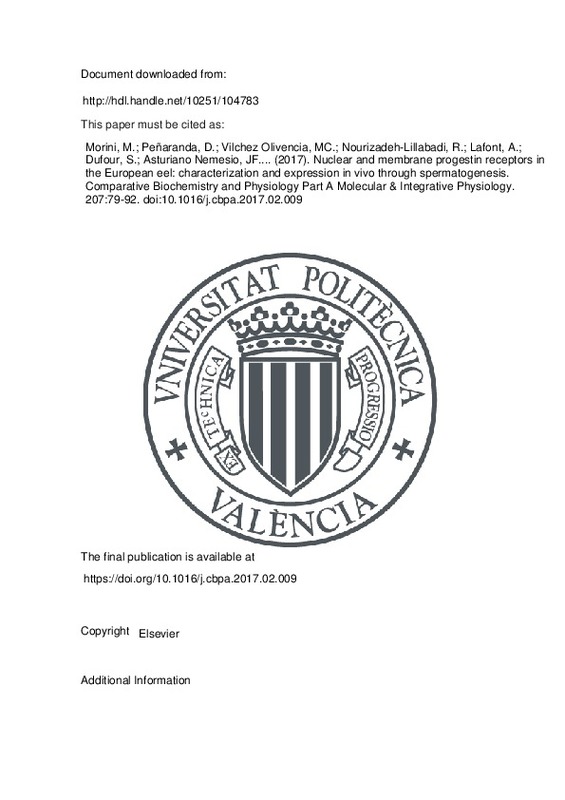|
Resumen:
|
[EN] Characterization of all the progestin receptor genes (PRs) found in the European eel has been performed. There were five membrane PRs (mPRs): mPR alpha (alpha), mPRAL1 (alpha-likel), mPRAL2 (alpha-like2), mPRy (gamma), ...[+]
[EN] Characterization of all the progestin receptor genes (PRs) found in the European eel has been performed. There were five membrane PRs (mPRs): mPR alpha (alpha), mPRAL1 (alpha-likel), mPRAL2 (alpha-like2), mPRy (gamma), mPR delta (delta) and two nuclear PRs (nPRs or PGRs): pgr1 and pgr2. In silico studies showed that the C and E(F) domains of Pgr are well conserved among vertebrates whereas the A/B domain is not. Phylogeny and synteny analyses suggest that eel duplicated pgr (pgr1 and pgr2) originated from the teleost-specific third whole genome duplication (3R). mPR phylogeny placed three eel mPRs together with the mPRce Glade, being termed mPRet, mPRAL1 and mPRAL2, while the other two eel mPRs clustered with mPRy and mPRS clades, respectively. The in vivo study showed differential expression patterns along the brain-pituitary-gonad axis. An increase in nPR transcripts was observed in brain (in pgrl) and pituitary (in pgrl and pgr2) through the spermatogenesis, from the spermatogonia B/spermatocyte stage to the spermiation stage. In the testis, mPRy, mPRS and pgr2 transcripts showed the highest levels in testis with A spermatogonia as dominant germ cell, while the highest mPRce, mPRAL1 and mPRAL2 transcripts were observed in testis from spermiating males, where the dominant germ cell were spermatozoa. Further studies should elucidate the role of both nuclear and membrane progestin receptors on eel spermatogenesis.
[-]
|
|
Código del Proyecto:
|
info:eu-repo/grantAgreement/MICINN//AGL2010-16009/ES/MECANISMOS FISIOLOGICOS IMPLICADOS EN LA ESPERMIACION Y EN LA ADQUISICION DE MOTILIDAD ESPERMATICA EN LA ANGUILA EUROPEA (ANGUILLA ANGUILLA)/
...[+]
info:eu-repo/grantAgreement/MICINN//AGL2010-16009/ES/MECANISMOS FISIOLOGICOS IMPLICADOS EN LA ESPERMIACION Y EN LA ADQUISICION DE MOTILIDAD ESPERMATICA EN LA ANGUILA EUROPEA (ANGUILLA ANGUILLA)/
info:eu-repo/grantAgreement/EC/H2020/642893/EU/Improved production strategies for endangered freshwater species./
info:eu-repo/grantAgreement/EC/H2020/COST Action FA1205/EU/:AQUAGAMETE/
info:eu-repo/grantAgreement/COST//FA1205/EU/Assessing and improving the quality of aquatic animal gametes to enhance aquatic resources - The need to harmonize and standardize evolving methodologies, and improve transfer from academia to industry/
info:eu-repo/grantAgreement/MINECO//AGL2013-41646-R/ES/LA ANGUILA EUROPEA COMO MODELO PARA ESTUDIAR LA TEMPERATURA COMO MODULADOR DE LA MADURACION SEXUAL EN TELEOSTEOS. POTENCIAL APLICACION EN ACUICULTURA./
info:eu-repo/grantAgreement/UPV//PAID%2F2011-S2-02-6521/
info:eu-repo/grantAgreement/UPV//PAID/2011-S2-02-6521/
info:eu-repo/grantAgreement/MICINN//PTA2011-4948-I/ES/PTA2011-4948-I/
[-]
|
|
Agradecimientos:
|
This work was supported by the Spanish Ministry of Science and Innovation (SPERMOT project; AGL2010-16009; REPRO-TEMP project, AGL2013-41646-R), and IMPRESS (Marie Sklodowska Curie Actions Innovative Training Network; Grant ...[+]
This work was supported by the Spanish Ministry of Science and Innovation (SPERMOT project; AGL2010-16009; REPRO-TEMP project, AGL2013-41646-R), and IMPRESS (Marie Sklodowska Curie Actions Innovative Training Network; Grant agreement no: 642893). M.C. Vilchez has a predoctoral grant from UPV PAID Programme (2011-S2-02-6521), M. Morini has a predoctoral grant from Generalitat Valenciana (Programa Grisolia), D.S. Penaranda was supported by MICINN and UPV (PTA2011-4948-I). Grants to attend meetings were funded by COST Office (COST Action FA1205: AQUAGAMETE).
[-]
|







![[Cerrado]](/themes/UPV/images/candado.png)


